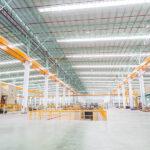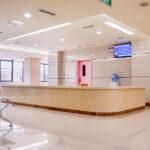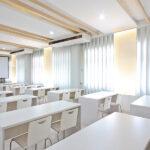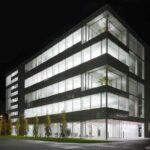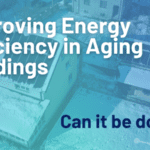Chiller systems are essential to cooling large commercial and industrial buildings. Optimizing or replacing outdated equipment with modern, high-efficiency chillers can dramatically lower energy use, improve comfort, and support your organization’s carbon reduction goals.
Table of Contents
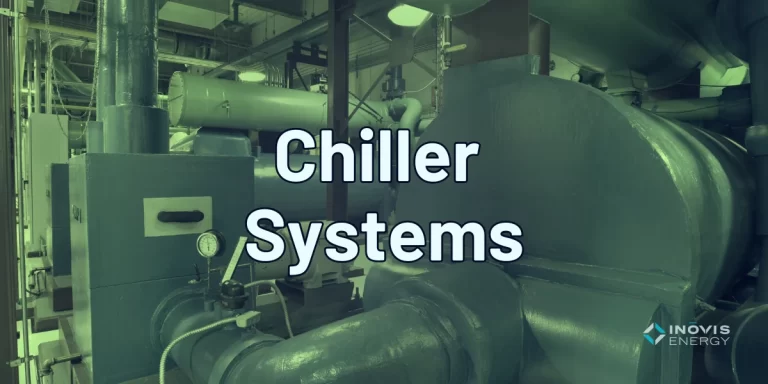
What Are Commercial Chiller Systems?
Commercial chillers remove heat from water using a vapor-compression or absorption cycle. This chilled water is then distributed through air handlers or coils to cool interior spaces or equipment.
Chillers are central to mechanical cooling systems in many types of facilities, including hospitals, schools, data centers, and manufacturing plants. Common types of chillers include:
-
Air-Cooled Chillers – Use ambient air to cool refrigerant; simpler and lower maintenance, ideal for smaller buildings or retrofit scenarios.
-
Water-Cooled Chillers – Use water from a cooling tower for heat rejection; more efficient for large cooling loads or high-performance buildings.
-
Evaporative Condensed Chillers – Combine air and water cooling for enhanced efficiency.
-
Turbocor or Magnetic Bearing Chillers – Use oil-free, variable-speed compressors for ultra-high efficiency and quiet operation.
-
Screw and Scroll Chillers – Designed for mid- to large-scale applications with steady load profiles.
Future child pages can go deeper into each system type and retrofit strategy.
Benefits of Upgrading to High-Efficiency Chiller Systems
-
Lower Energy Costs: New chillers consume significantly less electricity, especially during partial load conditions.
-
Improved Comfort & Performance: More consistent cooling, better humidity control, and quieter operation.
-
Reduced Maintenance Needs: Fewer moving parts (especially with magnetic bearing chillers) and smarter diagnostics extend service intervals.
-
Extended Equipment Life: Right-sized, properly controlled systems run less often and experience less wear.
-
Smaller Carbon Footprint: Enhanced energy efficiency reduces greenhouse gas emissions and supports ESG goals.
-
Eligibility for Incentives: Many utilities offer rebates and performance incentives for qualifying chiller upgrades.
-
Smart Building Integration: Modern chillers connect to BMS platforms for better load optimization and predictive maintenance.
-
Future-Ready Cooling: Positions your facility to meet evolving regulations around refrigerants, efficiency, and climate targets.
How Chiller Systems Work
A chiller operates by circulating refrigerant through a closed-loop cycle involving compression, condensation, expansion, and evaporation. Heat is removed from water in the evaporator, and then rejected via air or water in the condenser. The cooled water is circulated through the building’s cooling system via pumps and piping, often with support from cooling towers, supply/return valves, and digital controls.
How Efficient Chiller Systems Save Energy
mModern chiller systems are designed with efficiency in mind. Here’s how they reduce energy use compared to legacy systems:
-
Variable Frequency Drives (VFDs): Match output to cooling demand in real time, reducing wasted energy during partial load.
-
High-Efficiency Compressors: Advanced compressor technologies (like magnetic bearing compressors) minimize friction and mechanical losses.
-
Condensing Technology: Water-cooled and evaporative systems reclaim waste heat or use ambient conditions to improve efficiency.
-
Smarter Controls: Automated sequencing, setback schedules, and demand response features reduce runtime and optimize peak load performance.
-
System Integration: Modern chillers communicate with Building Management Systems (BMS) to harmonize cooling with ventilation, occupancy, and time-of-day conditions.
Many facilities can see 20–40% reductions in cooling energy usage after a chiller retrofit—especially when upgrading from oversized or constant-speed legacy systems.
Industries Benefitting from Efficient Chiller Systems
Related Facilities
Chiller upgrades are ideal for:
-
Buildings with year-round cooling loads
-
Facilities with aging or oversized equipment
-
Complexes using outdated screw or reciprocating chillers
-
Municipal campuses or schools with central plant systems
-
Energy-intensive or process-driven environments (labs, manufacturing, etc.)
Our Chiller Upgrade Process
-
Site Audit – Assess existing system capacity, efficiency, controls, and mechanical layout
-
Design Engineering – Select chiller type, load sizing, and heat rejection strategy
-
Rebate & Financial Modeling – Evaluate utility incentives and ROI
-
Procurement & Installation – Coordinate phasing to minimize downtime
-
Commissioning – Verify system performance and calibrate controls
-
Post-Install Support – Offer maintenance options and monitoring integration
Financing Options for Chiller Upgrades
-
Utility Rebates – Available for high-efficiency chillers and controls
-
Energy Performance Contracts (EPC) – Pay for upgrades through savings
-
Capital Lease or On-Bill Financing – Spread costs over time
-
Public Sector Grant Support – For municipalities, schools, and housing authorities
Inovis manages incentive applications on your behalf to simplify the process.
Contact Us for Chiller Upgrades
A high-efficiency chiller upgrade can cut operating costs, lower your carbon footprint, and improve comfort across your facility. Let Inovis assess your existing system and show you what’s possible.

